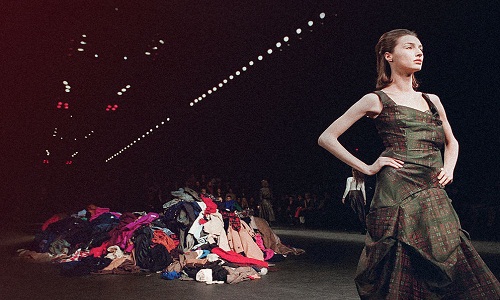"Fashion retailers are feeling the heat from warming winter. According to Co. Design, a Patagonia spokesperson, climate change ‘a serious crisis’ for its business. And while retailers like J. Crew, H&M, and Nordstrom decline to comment, the numbers speak for themselves. Uniqlo, H&M, and Gap all announced major seasonal shortfalls this year, and Macy’s is actually cutting more than 4,500 jobs following slumpish holiday sales, blaming 80 per cent of its revenue shortcomings on cold-weather goods like jackets, hats, and scarves that just didn’t sell."

Fashion retailers are feeling the heat from warming winter. According to Co. Design, a Patagonia spokesperson, climate change ‘a serious crisis’ for its business. And while retailers like J. Crew, H&M, and Nordstrom decline to comment, the numbers speak for themselves. Uniqlo, H&M, and Gap all announced major seasonal shortfalls this year, and Macy’s is actually cutting more than 4,500 jobs following slumpish holiday sales, blaming 80 per cent of its revenue shortcomings on cold-weather goods like jackets, hats, and scarves that just didn’t sell.
Experts in the fashion industry are already speaking openly about how climate change is transforming their business models, their designs, and the very notion of seasonal fashion itself.
Preplanning collections

It’s a common practice for winter fashion to hit shelves in July. Those heavy pieces may have hit catwalks and started the journey to production anywhere from 6 to 18 months before they arrived in a store. And yet, for all this preplanning, nobody buys a winter coat in the sweltering days of summer - and some brands are beginning to question the long lead time.
Says Yael Aflalo, Founder and CEO of fast US fashion brand Reformation, typically the way the industry is set up is a little odd, where you sell sweaters in July in anticipation of September. It becomes this game of racing to get a fresh product a little too early. Most people buy sweaters when it’s cold outside. Aflalo has built her business on limited-run clothing, produced only four to six weeks before it reaches shelves. This year, as warm weather stuck around, the company's unusually short production pace paid off and allowed it to quickly reassess how much winter stock it really needed.
Meanwhile, retailers have capitalised on delays that had summer items arriving in Fall. Rebecca Minkoff admits that her business had a lucky break in this seasonal scheduling. While they had planned to ship a suede jacket in July, a delay in the tannery pushed it back to October and November. To anyone outside the fashion industry, the idea of garments that are produced during the season in which they'll be worn seems obvious and logical - especially when it's increasingly tough to know what weather the next season has in store. In fact, that’s why Minkoff is changing the timing of seasonal shows. Instead of wooing retailers several seasons in advance to place speculative orders on what people might want months in the future, Minkoff is running consumer-facing runway shows closer to actual ship dates.
Traditionally, designers show their Fall line in February -- seven to eight months before anyone wears it. Minkoff is showing Spring in February, just a month before the season starts. This new show strategy, helps as consumers not just retailers have the option to buy the entire line right then. Not every retailer will be able to change its seasonal show schedule. As Minkoff points out, larger, more traditional retailers will need to learn how to juggle inventory across regions. If a city is colder than expected, these retails should have systems for getting those stores the cold goods, ASAP.
Designing for future
To some extent, the global, jet setting economy has already pushed designers to consider new, more environmentally-flexible fabrics. With everybody traveling so much, there’s a lot of things like lightweight wool that goes from tropics to winter places, or smart fabrics that can respond to clues in the event to get warmer or cooler. Some of the big companies interested in techno luxury, like Venia, are exploring those.
Adapting doesn’t necessarily need to be as complicated as inventing in super-advanced fabrics. For Reformation, it was a matter of skewing towards the right textiles and designs. Aflalo says, people are going to be more opting for things like medium weights. And as the weather stayed warmer than expected this fall, the company countered by releasing a more balanced assortment of middle weight items, more things like dresses, basic tops, more jeans, more things that are not as dependent on weather. The more obvious shift may not be the timing of clothing sales, but the design of the clothing itself.
Ironically, even in warmer climates, traditional winter fashion continue to define warm winter fashion. The heaviest of coats and sweaters, when produced in more limited supplies, will inherently become the statement pieces of the season, the rarer luxury garments for those who can afford to do more than dress in layers 12 months a year.
Winter seasonal items may no longer designed around the bulky, functional necessity of warmth, meaning they could be defined by a whole new aesthetic. Aflalo believes in human creativity. When there's less ability to be creative, then you figure out how to be more creative. Humans are remarkable creatures like that, she concludes.












